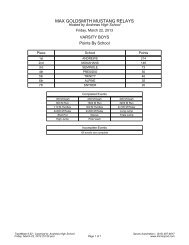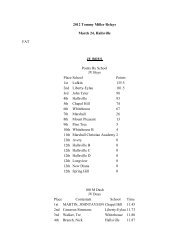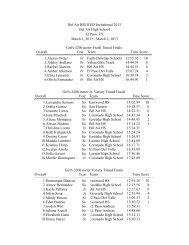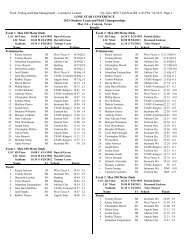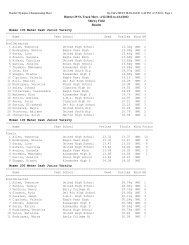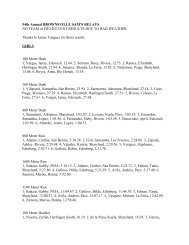1. PAGES 1-35 - Texas Track & Field Coaches Association
1. PAGES 1-35 - Texas Track & Field Coaches Association
1. PAGES 1-35 - Texas Track & Field Coaches Association
You also want an ePaper? Increase the reach of your titles
YUMPU automatically turns print PDFs into web optimized ePapers that Google loves.
HIGH SCHOOL REPORT<br />
IAAF COACHES COMMISSION REPORT<br />
WAYNE CLARK<br />
VICTOR LOPEZ<br />
CHAIRMAN, IAAF COACHES COMMISSION<br />
Recently the Ohio <strong>Association</strong> of <strong>Track</strong> & Cross Country <strong>Coaches</strong><br />
recognized the 75th anniversary of Jesse Owens establishing four<br />
world records during one track meet. I thought you might like to<br />
read a little history about this great track and field performer.<br />
Loving to run, Jesse began his track career in junior high school<br />
becoming an exceptional talent in the sprints. During his high school<br />
days at Cleveland East Tech Owens established the national high school<br />
record in the long jump and equaled the world record in the 100-yard<br />
dash at 9.4 seconds. Because of an after-school job, Jesse practiced<br />
mostly on his own before school each day. Yet, Jesse persevered.<br />
Unbelievable by today’s standards, Jesse attended Ohio State University<br />
without a scholarship. Also, in that time period, because he was African<br />
American, he was banned from living and eating with his white university<br />
teammates, was given individual travel arrangements, and had to work a<br />
part-time job to help pay for his tuition. But Jesse persevered.<br />
It was just over 75 years ago, in 19<strong>35</strong>, that Jesse set four world records<br />
within a 45 minute time period in the Big Ten Championships. He tied<br />
his own WR in the 100 yard dash and smashed the WR in the 220, the<br />
broad jump, and the 220 low hurdles. Some sports enthusiasts claim<br />
this meet to be the most valiant sports accomplishment of all-time.<br />
This achievement in just 45 minutes! Jesse persevered.<br />
Not only was Jesse a tremendous athletic ambassador for track and<br />
field, but in the highly racially motivated 1936 Berlin Olympic Games,<br />
Jesse won four gold medals, making him an ambassador for all<br />
mankind. After these accomplishments Jesse became somewhat more<br />
accepted, but he was not recognized by any U.S. President until Dwight<br />
Eisenhower honored Owens as an “Ambassador of Sports” in 1955.<br />
Throughout, Jesse persevered.<br />
After his 1936 Olympic successes, Owens was obligated to continue<br />
racing in Europe without expenses or funding. He became homesick<br />
and returned to the United States without “permission”. His amateur<br />
status was immediately revoked by USOC President Avery Brundage,<br />
and Jesse was left with few resources for his family. Jesse’s life was sustained<br />
by periodic involvements with failed businesses, exploitation of<br />
racing against horses, as well as employment as a gas station attendant.<br />
Fortunately, Jesse’s family remained lovingly true to him. But, during<br />
his deepest lifetime low, Jesse had to file for bankruptcy. Remarkably,<br />
Jesse persevered.<br />
In later life Jesse traveled the world speaking for large corporations<br />
and the U.S. Olympic Committee, which had rejected him in prior<br />
years, relating his story and encouraging others of less fortunate circumstances<br />
to persevere.<br />
Perhaps Jesse’s story will encourage all of us to scrutinize our treatment<br />
of others, while encouraging those we coach to remain persistent<br />
in striving to achieve Jesse’s athletic accomplishments.<br />
Wayne Clark is the Clinic Chair of the Ohio <strong>Association</strong> of <strong>Track</strong> and<br />
Cross Country <strong>Coaches</strong>. He can be reached at clark002@columbus.rr.com.<br />
The 2003 IAAF Congress held in Paris, France approved<br />
a resolution to make athletics the number one sport in<br />
schools all over the world. We as coaches understood<br />
that this was a very important step in the development of<br />
track and field. Theold system which was used in most countries<br />
all over the world, the club system, was dying. Therefore,<br />
the IAAF Long Term Athlete Development Plan emphasis<br />
since 2003 has been to introduce athletics from the primary<br />
school up to high school in all the countries around the<br />
world. I pleased to say that the program is making progress<br />
with the introduction of the IAAF Kids Athletics program in<br />
elementary schools and with an emphasis in Youth competition<br />
beyond the primary school. In the NACAC area, especially<br />
in the Central American and Caribbean region, the program<br />
is pretty much in place and making big strides with athletes<br />
all over the region producing fantastic results.<br />
I must say that, in the U.S., this system has been the bread<br />
and butter in the development of track and field. Seeing that<br />
the system has worked in U.S. and other countries like<br />
Jamaica, Cuba, the Bahamas, Puerto Rico and elsewhere, the<br />
IAAF understood that this was the way to go. But where the<br />
U.S. really is a mile apart from the rest of the world is in the<br />
development of track and field beyond the secondary schools.<br />
The U.S., with its NCAA program, has perhaps one of the best<br />
if not the best high performance development systems in the<br />
world. No other country in the world has a system of three<br />
divisions like in the NCAA, a system in the NAIA and a system<br />
in the junior colleges, where athletes receive a scholarship to<br />
study and to participate in athletics at that particular university<br />
or college. Puerto Rico has a similar program, maybe the<br />
equivalent of the NCAA Division II, where there is a university<br />
league composed of 21 institutions where the competition<br />
in a number of sports is as intense as in the U.S. and the athletes<br />
receive scholarships like in the U.S. I believe universities<br />
in Jamaica are starting to do the same.<br />
Where else can you get a four- or five-year education, practice<br />
the sport under the best coaches, have use of the best<br />
facilities and compete in a top-notch program? The only<br />
place that we know which has a program of that magnitude is<br />
in the U.S. Therefore, the IAAF aspiration is that all the countries<br />
around the world follow that example because it has<br />
proven that it is the best.<br />
I would like to congratulate all the members of the<br />
USTFCCCA for the fantastic job that they do year in year out<br />
in developing athletes—not only from the U.S., but from<br />
other countries as well.<br />
Victor Lopez can be reached at victorlp8@aol.com.<br />
AUGUST 2011 techniques 7



